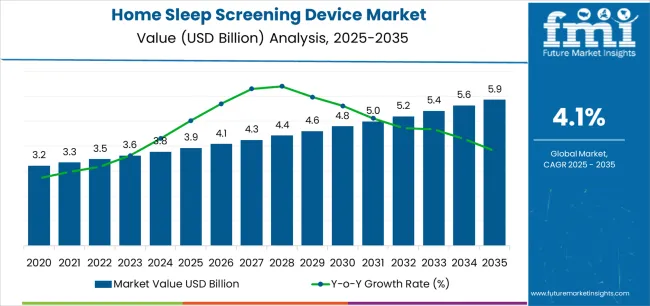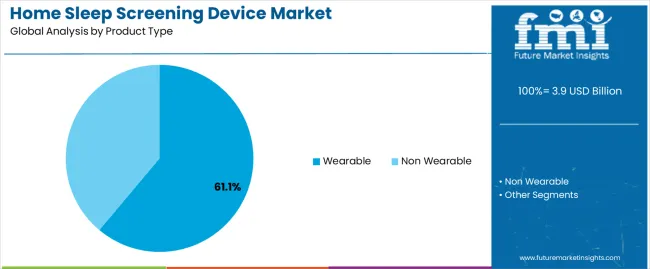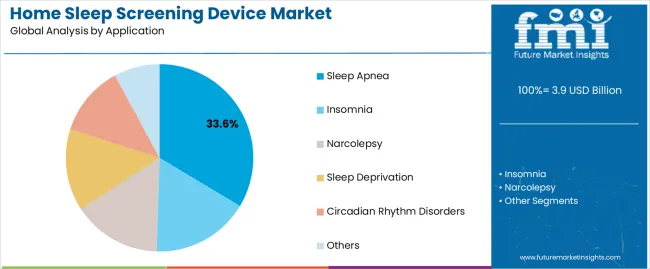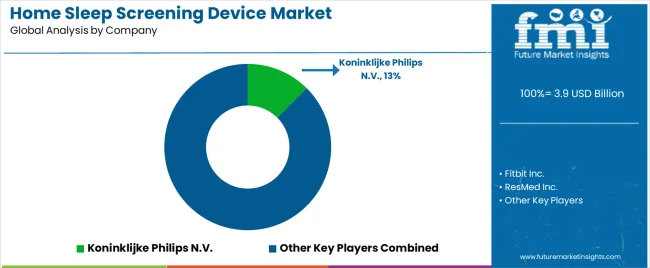The Home Sleep Screening Device Market is estimated to be valued at USD 3.9 billion in 2025 and is projected to reach USD 5.9 billion by 2035, registering a compound annual growth rate (CAGR) of 4.1% over the forecast period.
The Home Sleep Screening Device market is experiencing robust growth, driven by increasing awareness of sleep-related disorders and the rising prevalence of conditions such as sleep apnea, insomnia, and restless leg syndrome. Growing demand for home-based diagnostics is being supported by the convenience, affordability, and accessibility of devices that allow patients to monitor sleep patterns without visiting clinical centers. Advancements in wearable sensor technology, AI-powered analytics, and cloud-based data processing have enhanced the accuracy and reliability of these devices, making them suitable for clinical and consumer use.
Integration with mobile applications and healthcare platforms is enabling remote monitoring and personalized care, further accelerating adoption. Regulatory focus on healthcare quality, patient safety, and data privacy has encouraged manufacturers to develop compliant and user-friendly solutions.
As healthcare systems seek cost-effective strategies for early diagnosis and continuous monitoring, the market is expected to expand steadily Continuous technological innovation, rising healthcare expenditure, and increasing patient engagement in self-monitoring practices are driving long-term growth, positioning home sleep screening devices as a key component of digital health ecosystems.

| Metric | Value |
|---|---|
| Home Sleep Screening Device Market Estimated Value in (2025 E) | USD 3.9 billion |
| Home Sleep Screening Device Market Forecast Value in (2035 F) | USD 5.9 billion |
| Forecast CAGR (2025 to 2035) | 4.1% |
The market is segmented by Product Type, Application, and Distribution Channel and region. By Product Type, the market is divided into Wearable and Non Wearable. In terms of Application, the market is classified into Sleep Apnea, Insomnia, Narcolepsy, Sleep Deprivation, Circadian Rhythm Disorders, and Others. Based on Distribution Channel, the market is segmented into Online Sales, Pharmacy, Retail Stores, Hypermarkets And Supermarkets, and Others. Regionally, the market is classified into North America, Latin America, Western Europe, Eastern Europe, Balkan & Baltic Countries, Russia & Belarus, Central Asia, East Asia, South Asia & Pacific, and the Middle East & Africa.

The wearable product type segment is projected to hold 61.1% of the market revenue in 2025, establishing it as the leading product type. Growth in this segment is being driven by the convenience, portability, and continuous monitoring capabilities offered by wearable devices, which allow users to track sleep patterns in real time. Advanced sensors embedded in wearables can monitor multiple physiological parameters, including heart rate, oxygen saturation, and movement, which improve diagnostic accuracy for conditions such as sleep apnea.
Integration with mobile applications enables real-time feedback and personalized health insights, enhancing patient engagement. The ability to collect long-term data and transmit it to healthcare providers for remote analysis increases clinical relevance and adoption.
Wearable devices are also supported by growing consumer interest in wellness tracking and preventive healthcare solutions As technology continues to evolve with improved battery life, sensor sensitivity, and AI-based analytics, wearable devices are expected to maintain their market leadership, supported by widespread adoption across clinical and home-based applications.

The sleep apnea application segment is anticipated to account for 33.6% of the market revenue in 2025, making it the leading application area. Growth in this segment is being driven by the high prevalence of obstructive and central sleep apnea globally and the need for early diagnosis and effective management. Home sleep screening devices enable continuous monitoring of respiratory patterns, oxygen saturation, and sleep cycles, providing critical data for clinical assessment and therapy planning.
The integration of AI-driven analytics allows for precise detection of apnea events and personalized feedback, improving treatment adherence and outcomes. Growing awareness among patients and healthcare providers regarding the risks of untreated sleep apnea, including cardiovascular complications and daytime fatigue, is accelerating adoption.
The convenience and cost-effectiveness of home-based monitoring compared with traditional in-lab polysomnography further strengthen demand As healthcare systems focus on preventive care and patient-centric solutions, the sleep apnea segment is expected to continue driving market growth, supported by ongoing technological innovation and increasing acceptance of home-based diagnostics.

The online sales distribution channel segment is projected to hold 41.8% of the market revenue in 2025, establishing it as the leading channel. Growth in this segment is being driven by the increasing adoption of e-commerce platforms for medical devices and consumer health products, providing convenience, wider availability, and competitive pricing. Online channels enable manufacturers to reach a broader customer base, including remote and underserved regions, while offering features such as detailed product information, reviews, and customer support.
The COVID-19 pandemic accelerated the shift toward online healthcare purchases, and this trend continues to influence market dynamics. Direct-to-consumer sales through websites and digital marketplaces reduce dependence on physical retail stores and enable rapid distribution and timely delivery.
Integration with digital marketing strategies and telehealth platforms further enhances adoption by creating seamless purchasing and follow-up experiences As consumer preference for online shopping and telemedicine grows, the online sales channel is expected to remain the primary driver of market expansion, supported by increasing digital literacy and trust in e-commerce platforms for health-related products.
The availability of various home sleep screening devices gives consumers a wide range of options. Wearables, portable sleep monitors, bedside sleep monitors, sleep tracking pads, and various smartphone applications exist. Among all of these, the wearable segment has been gaining traction in the global home sleep screening device market.
Accessibility of these devices and personalized insights from them make them even more popular among consumers of varying age groups. These devices make it convenient to keep tabs on sleep quality in the comforts of home, saving money and time on clinic visits.
Users may receive a personalized understanding of their sleep habits using advanced analytics and AI algorithms. This enables customized suggestions to enhance sleep quality and general well-being.
The analysts at Future Market Insights opined that when they analyzed the home sleep screening devices market for 4 years, 2020 to 2025, it gained an 8.40% CAGR. This has the probability to gradually reduce to 4.30 CAGR during a span of 10 years, from 2025 to 2035.
| Historical CAGR (2020 to 2025) | 8.40% |
|---|---|
| Forecast CAGR (2025 to 2035) | 4.30% |
Escalating sleep disorders globally to push manufacturers towards developing advanced and integrated home sleep screening devices. Various reasons, such as lifestyle decisions, excessive screen time, and irregular sleeping patterns, can cause sleep disruptions.
Psychological factors like stress, depression, and anxiety are just as important as physical conditions like persistent pain and sleep apnea to cause sleep troubles. Sleep disorders can result from environmental variables that disturb sleep patterns, such as noise and unpleasant sleeping surroundings, which can affect the overall quality of sleep.
Consumers are in dire need of effective readings of their sleep cycles and also the various phases of the sleep cycle. They opt for wearables that can effectively track their deep sleep, light sleep, REM, and awake timings. The market payers are thus working towards improving these features in their devices.
Better Diagnosis of Health Patterns and Sleep Disorders to Push Demand
Digital tools that record bio signals and multidimensional sleeping data, such as consumer wearable and unwearable sleep devices (e.g., smartwatches, wristbands, and rings), have great potential for use in clinical settings, particularly within the safety net health system.
These are reasonably priced devices that allow patients and healthcare professionals to share information and receive real time feedback. Medical practitioners can also monitor and detect patients' sleep wake patterns, which improves treatment responses and recovery.
They may positively affect clinic level outcomes, such as cost and staffing. Market players, including both fitness brands and healthcare accessory brands, are leveraging the features of these devices to get precise and exact results.
Home Sleep Screening Devices face Glitches Regarding the Sleep Pattern Recordings
Consumers doubt the accuracy of the data. This can be a serious concern for the market players. For instance, in the case of wearable devices, sleep tracking may malfunction at times if the band or the ring is not tightly in touch with the skin. This will deter the device from getting a proper reading and, hence, wrong outcomes. Market players thus need to make these more efficient.
Being at rest does not mean a person is sleeping. Some of these home sleep screening devices face glitches as they start to record to sleep cycle, even when the user is sitting on a couch or going for a spa session.
This section provides a detailed analysis of two particular market segments for the home sleep screening device, the dominant product type, and the significant indication. The two main segments discussed below are wearables and sleep apnea.
| Product Type | Wearables |
|---|---|
| Market Share in 2025 | 61.10 |
In 2025, the wearable devices acquired a significant market share of 61.10% globally. The consumer trend is towards wearable devices in this market rather than the other product types. The common types of wearables are bands and rings. They are built with embedded actigraphy to monitor actions, pulse, and continuous blood oxygen saturation.
The heart rate variability, oxygen desaturation index, sleep phases, and surrogates for sleep vs wake duration may all be calculated using these measures.
The market players offer a universal charging connector for these devices, and is available in small, medium, and large sizes. Users may see a brief overview of their oxygen desaturation frequency, sleep stage distribution, and sleep architecture via a linked mobile app.
| Indication | Apnea |
|---|---|
| Market Share in 2025 | 33.60% |
In 2025, the home sleep screening device was dominantly used to detect sleep apnea. In this condition, regular breathing malfunctions, restricting oxygen flow throughout the body.
With the screening devices, the breathing patterns can be effectively investigated, along with sleep wake timings and REM timings. This will help a medical practitioner to detect how acute sleep apnea is and how to start the treatment.
This section will detail the home sleep screening device markets in key countries, including the United States, Germany, Spain, India and Thailand. The below section will emphasize the reasons that are pushing growth in each of the regions.
| Countries | CAGR from 2025 to 2035 |
|---|---|
| The United States | 1.60% |
| Germany | 4.30% |
| Spain | 4.70% |
| India | 5.60% |
| Thailand | 4.30% |
Demand will automatically increase if it satisfies the consumers. Many Americans are interested in utilizing technologies like wearable technology or smartphone applications to track and learn about their sleeping habits to maximize the quality of their sleep.
An electronic sleep tracker has been used by more than one third of Americans (35%), according to a 2025 poll conducted by the American Academy of Sleep Medicine.
Around 77% of those who tried one said the sleep tracker was useful, and 68% said they modified their behavior due to what they learned. Customer satisfaction is pushing the demand in the United States with a 1.60% CAGR through 2035.
The home sleep screening device market in Germany is expected to expand with a 4.30% CAGR through 2035. German consumers, who are renowned for having an eco-conscious attitude, prioritize environmentally friendly items.
This niche market group is drawn to energy efficient, recyclable, or eco-friendly packaged home sleep screening equipment, which drives demand from customers who care about the environment.
A sustainable home sleep screening device becoming increasingly popular is the "Withings Sleep Analyzer" from Withings, a well-known business for its innovative health tech goods. Withings' dedication to sustainability is shown in the Sleep Analyzer's eco-friendly construction and packaging, which offers customers innovative sleep tracking capabilities.
The home sleep screening device industry in Spain is anticipated to reach a 4.70% CAGR from 2025 to 2035. As the prevalence of sleep apnea rises, so will demand for anti-snoring devices that may additionally mitigate it.
Spain's higher medical expenses have also raised consumer demand for reasonably priced, useful self-care items, such as anti-snoring devices.
The home sleep screening device ecosystem in India will likely evolve with a 5.60% CAGR during the forecast period. A unique combination of mounting obstructive sleep apnea (OSA) cases and restricted access to specialty sleep clinics contributes to the need for home sleep screening devices in India.
By filling in the infrastructural gap in healthcare and raising awareness of sleep health in general, home screening devices offer a practical and affordable way for people to evaluate the quality of their sleep and identify possible sleep disorders like OSA.
The importance of holistic wellness practices in Thai culture is one of the distinctive factors generating demand for home sleep diagnostic equipment. Thai culture strongly values preserving harmony and balance in all aspects of life, including sleep quality.
People are becoming more interested in using contemporary technologies that promote general well-being, which is why home sleep diagnostic tools are becoming more and more common among those looking to improve their overall health and energy. This has pushed the CAGR of Thailand home sleep screening devices industry to 4.30% through 2035.

Players in the home sleep screening device market seek scalability in many ways. To cut expenses and boost production efficiency, companies are streamlining their processes. Reaching a wider market is made possible by growing distribution networks.
Increased marketing initiatives and brand building projects aim to increase customer trust and brand awareness. Strategic alliances with IT companies and healthcare providers provide solutions that meet client demands. When taken as a whole, these strategies help market players remain competitive and scalable within the sector.
The key players in this market include:
Key Development by Market Players
| Report Attribute | Details |
|---|---|
| Growth Rate | CAGR of 4.30% from 2025 to 2035 |
| Market value in 2025 | USD 3,763.10 million |
| Market value in 2035 | USD 5,733.10 million |
| Base Year for Estimation | 2025 |
| Historical Data | 2020 to 2025 |
| Forecast Period | 2025 to 2035 |
| Quantitative Units | USD million for value |
| Report Coverage | Revenue Forecast, Company Ranking, Competitive Landscape, Growth Factors, Trends, and Pricing Analysis |
| Segments Covered | Product Type, Application, Distribution Channel, Region |
| Regions Covered | North America; Latin America; Western Europe; Eastern Europe; South Asia and Pacific; East Asia; The Middle East & Africa |
| Countries Profiled | The United States, Canada, Brazil, Mexico, Germany, The United Kingdom, France, Spain, Italy, Poland, Russia, Czech Republic, Romania, India, Bangladesh, Australia, New Zealand, China, Japan, South Korea, GCC Countries, South Africa, Israel |
| Key Companies Profiled | Koninklijke Philips N.V.; Fitbit Inc.; Huami Corporation; Garmin Ltd.; Fossil Group, Inc.; Huawei Technologies Co., Ltd.; ResMed Inc.; Responsive Surface Technology LLC; Simmons Bedding Company LLC; Dreams, Cleveland Medical Devices Inc.; NovaSom, Itamar Medical Ltd; Ez Sleep; ApneaMed; SleepWorks LLC; VirtuOx Inc. |
| Customisation Scope | Available on Request |
The global home sleep screening device market is estimated to be valued at USD 3.9 billion in 2025.
The market size for the home sleep screening device market is projected to reach USD 5.9 billion by 2035.
The home sleep screening device market is expected to grow at a 4.1% CAGR between 2025 and 2035.
The key product types in home sleep screening device market are wearable and non wearable.
In terms of application, sleep apnea segment to command 33.6% share in the home sleep screening device market in 2025.






Full Research Suite comprises of:
Market outlook & trends analysis
Interviews & case studies
Strategic recommendations
Vendor profiles & capabilities analysis
5-year forecasts
8 regions and 60+ country-level data splits
Market segment data splits
12 months of continuous data updates
DELIVERED AS:
PDF EXCEL ONLINE
Home Healthcare Software Industry Analysis in North America Size and Share Forecast Outlook 2025 to 2035
Home Decor Market Size and Share Forecast Outlook 2025 to 2035
Home Automation Sensors Market Size and Share Forecast Outlook 2025 to 2035
Home Energy Management Systems Market Size and Share Forecast Outlook 2025 to 2035
Home Dialysis Systems Market Size and Share Forecast Outlook 2025 to 2035
Home Standby Gensets Market Size and Share Forecast Outlook 2025 to 2035
Home Scales Market Size and Share Forecast Outlook 2025 to 2035
Home Gym Equipment Market Size and Share Forecast Outlook 2025 to 2035
Home Brewing Systems Market Size and Share Forecast Outlook 2025 to 2035
Home Brew Boiler Market Size and Share Forecast Outlook 2025 to 2035
Homeland Security Market Size and Share Forecast Outlook 2025 to 2035
Home Wi-Fi Security Solutions Market Size and Share Forecast Outlook 2025 to 2035
Home Security Drone Market Size and Share Forecast Outlook 2025 to 2035
Home Healthcare Market Analysis - Size, Share, and Forecast Outlook 2025 to 2035
Homeopathic Products Market Analysis - Size, Share, & Forecast Outlook 2025 to 2035
Home Care Services Market Size, Growth, and Forecast 2025 to 2035
Home Office Spending Market by Solution Deployment, Application & Region Forecast till 2025 to 2035
Home Baking Ingredients Market Growth - Consumer Trends 2025 to 2035
Home Respiratory Therapy Market – Growth & Forecast 2025 to 2035
Home Elevator Market Growth – Trends & Forecast 2025 to 2035

Thank you!
You will receive an email from our Business Development Manager. Please be sure to check your SPAM/JUNK folder too.
Chat With
MaRIA